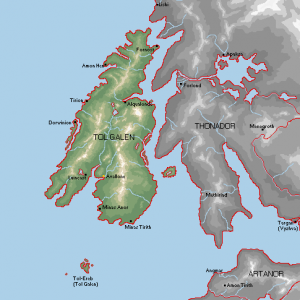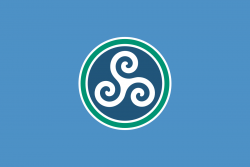Tol Galen
| Kingdom of Tol Galen Calendor | |
|---|---|
|
Flag | |
|
Motto: Úlúva, Úcúna, Úluhtaina Unbowed, Unbent, Unbroken | |
|
Anthem: I Vow To Thee, My Country Royal anthem: The Queen's Song | |
 | |
| Location | Vinya |
| Capital | Avallónë |
| Official languages |
Galenic Common |
| Recognised regional languages |
Yakut Kazakh Dayanese |
| Ethnic groups |
83% White 7.2% Asian 5.3% Mixed 4.5% Other |
| Religion |
49.5% Polytheistic 23.9% Irreligious 21.7% Christianity 1.5% Shamanism 7% Other |
| Demonym | Galenite |
| Government | Federal Monarchy |
• Queen | Jane I |
• Prime Minister | Aisling Fitzgerald |
• Chief Justice | Hugh Fry |
| Legislature | Galenic Parliament |
| Galenic Senate | |
| National Assembly | |
| Area | |
• Total | 649,260 km2 (250,680 sq mi) |
| Population | |
• 2020 estimate | 143,821,119 |
• 2010 census | 135,486,492 |
• Density | 195.15/km2 (505.4/sq mi) |
| GDP (PPP) | 2016 estimate |
• Total | $6.227 trillion |
• Per capita | $45,960 |
| GDP (nominal) | 2016 estimate |
• Total | $5.627 trillion |
• Per capita | $41,531 |
| Gini (2015) |
25.5 low |
| HDI (2015) |
very high |
| Currency | Galenic Dollar (GLD) |
| Time zone | (UTC-10) |
• Summer (DST) | (UTC-9) |
| Date format | dd/mm/yyyy |
| Drives on the | left |
| Calling code | 836 |
| ISO 3166 code | TGL |
| Internet TLD | .tgl / .tg / .co.tg |
Tol Galen, formally the Kingdom of Tol Galen is a sovereign state located off the western coast of Casaterra in Septentrion. It has a total land area of 649,260 square kilometres. Tol Galen has second largest population and economy in Casterra with over 135 million citizens and a GDP of over $5.6 trillion. Tol Galen is a former colony of New Tyran having gained independence in 1902 and now leads an economic union in Vinya.
Tol Galen is considered to be a Nordic nation but due to conquest by New Tyran there has been substantial Tyrannic cultural and linguistic influence, most notably the use of Common as the primary language of Tol Galen rather than Galenic.
Contents
Etymology
The name Tol Galen derives from the Sindarin Tol (Island) and Calen (Green), it is also known more informally as Calendor which translates to Green Land.
History
Prehistory and Early History
The lands which now make up Tol Galen are thought to have been discovered around 675 CE by settlers from what is now Aversgard, there is archaeological evidence that they set up at least three settlements on the East Coast of Tol Galen and on the Island of Tol Brandir. However, archaeological evidence points towards increasing amounts of settlers making the journey between ~730-810 these settlements predominantly appear to be what could reasonably be called fishing villages again, primarily along the East coast. It is hypothesised and indeed archaeological evidence has been unearthed that first settlement must have occurred prior to re-discovery due to cereal pollen from domesticated plants and middens of shellfish shells having been found and dated to ~7500 BC. As of yet not been a definitive settlement found that pre-dates or coincides with the settlement of the East coast. What is known that settlers encountered local people, taking them as slaves and concubines.
During the Viking Age settlement is shown to have further increased as larger more permanent settlements were formed coinciding with the expansion into western Casaterra and Vinya by Norse settlers. These people were primarily of Aversgardian and Jedorian origin. DNA evidence points toward Turkic and other Nordic populations some of whom were surely slaves and servants of the now established chiefs, taken into servitude and slavery during raids en-route to Calendor.
Given the sacking of aboriginal sites in what is now Andor it is perhaps unsurprising that archaeological discoveries have been made further inland that point towards populations fleeing from ever increasing incursions from Aversgard and beyond. This is further reinforced by the still extant fortified settlements in the foothills of Northfarthing. It would seem that the Norse were either reluctant to or did not decide to venture further into the Galenic hinterland. Christianisation seems to have started to have started in the late-tenth and early-eleventh centuries but never quite took hold. Historical accounts point towards widespread violence between the two major rival religious factions culminating in outright civil war. The eventual outcome was similar to that had had occurred elsewhere in that Christianity would be adopted by arbitration whilst retaining the old customs and allowing private polytheistic worship to continue.
Initial Expansion
During the period between 1050-1150 what is now Tol Galen evolved into a series of thirteen rival kingdoms and city states. Between 1050 and the onset of the War of Unification in 1177 the population grew from roughly 120,000 to around 800,000 with the vast majority of that figure centred on the existing east coast settlements and the reasonably new settlements around the Gulf of Lhûn. Inward expansion had started by following the River Lhûn northwards, further coastal settlements began to spring up on the West coast as fishermen expanded the areas in which they sailed.
War And Unification
By the late 12th century, the 13 minor kingdoms had through war and marriage become seven, also known as the Heptarchy.
The decline of the Heptarchy and eventual emergence of the kingdom of Tol Galen was a drawn-out process, taking place over the course of the remainder of the 12 and most of the 13th century. Wars and marriages between the seven kingdoms eventually lead to there being two, split by the great river Anduin. In 1286, the respective kings, queens and their entourages met at lake along the course of the Anduin (latterly Osgiliath) to discuss terms for union in the face of growing expansion from other Casterran powers in the Crimson Sea who were beginning to expand their spheres of influence. What resulted was the establishment of a diarchy which lasted until colonisation by New Tyran.
The Black Death
Between 1322 and 1350 a relative air of peace had seen Tol Galen begin to get into its stride as a nation, without warring factions bickering for power the nation was free to expand in all areas. The population boomed as did trade with Casaterra proper and Hemithea, this would however set a chain of events in motion that would result in over a third of the population dying directly or indirectly from the bubonic and pneumonic plague.
The First Plague
The first known case of plague was a seaman who arrived in Luincast in 1350 from there reports of the same symptoms were appearing at ports up and down the coastline of Tol Galen. The initial outbreak of what would be called the Black Death arrived. It survived the winter of 1350-51, but during the following winter it abated, with things returning to some sense of normality by late 1352.
The Second Plague
The plague returned again in 1366, this time to much more devastating effect due to an already weakened population being unable to cope with another more widespread outbreak. The second plague claimed as much as 10-15% of the population within the space of some six months.
The Final Plague
The final major outbreak of plague occurred during 1479-80 and was particularly virulent claiming nearly 20% of the remaining population. From this point onwards outbreaks became increasingly fewer and further between.
Crown Colony
After the ravages of consecutive plagues and resultant famines Tol Galen was a broken nation and in in 1490 the expanding Tyrannic empire had reached the shores of Tol Galen, between 1490 and 1555 numerous wars were fought between the two nations resulting in the eventual conquest and subjugation of the Galenic people until independence in 1902.
Crown Protectorate
After some two hundred years of subjugation Tol Galen had began its journey towards becoming a semi-independent protectorate. The reasoning given at the time being. "It is eminently more suitable to the kingdom, and more acceptable for subjects of the colony than direct dominion. It is cheaper, simpler, less damaging to their self-esteem, gives them more opportunities as public officials, and spares unnecessary bureaucracy over a nation which until their annexation were perfectly capable of ruling themselves'. True protectorate status would be a long time incoming and would take until the late 1700s. Formally reverting back to the name of Tol Galen in the early 1800s, by 1850 Tol Galen had been allocated the status of a 'responsible government' handling most of their own affairs again, this signalled the final stretch to achieving full independence in 1902.
Pan-Casterran War (1909-1914)
Work In Progress
Interbellum
Work In Progress
Pan-Septentrion War
Work In Progress
Descent Into Cold War
Work In Progress
Modern Tol Galen
Work In Progress
Government
Tol Galen is a Constitutional Federal Monarchy. The Galenic Government consists of a triad of separate branches under the crown they are; the executive, legislative and judicial branches. Further elements of and relating to governance of Tol Galen are outlined in the remainder of the Galenic constitution, which includes written statutes, court rulings, and unwritten conventions developed since 1902.
Administrative Divisions
The main island of Tol Galen is formed of eight separate entities classed either as Farthings or Waiths, they are: Northfarthing, Eastfarthing, Southfarthing, Westfarthing, Enedwaith, Haradwaith, Forodwaith and Tawarwaith. In addition there are the islands of Tol Brandir, Tolfalas, Tol Morwen, Tol Uialgaer and Tol Uinen which are self-governing crown dependencies.
